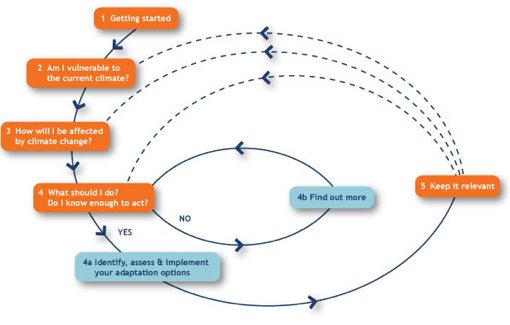Self-Assessment Tool
Introduction
The SaskAdapt Self-Assessment Tool can help individuals, farmers, ranchers, small businessmen and communities in Saskatchewan evaluate decisions about adapting to climate change. Large businesses, communities and government agencies, should also adapt (or may already be adapting), but they will usually follow a more rigorous and involved planning process because of the scale and complexity of their issues and interests. Specialized staff and/or consulting resources will normally be engaged in the process.

The Self-Assessment Tool guides individuals through a more simplified, but similar, planning process, so that you appreciate how you are impacted by weather and climate, how the climate may change and impact on your future activities, and what might be your options for adaptation. Adaptation options can range from taking advantage of new opportunities that may arise, say from warmer temperatures, to reducing or eliminating known risks from future climates. The Self-Assessment Tool can assist you in incorporating climate change in your planning for the future. This tool will help you to decide what actions you, your business or organization should take to better prepare for climate change.
Adaptation to climate change should be integrated into overall decision-making processes. Therefore as decisions are taken, evaluated and updated, climate change and the risks or opportunities it presents should consciously be part of that cycle. Incorporating climate change into decision-making may also require the involvement of new people, information and knowledge.
The Self-Assessment Tool will help start you on the path of incorporating climate change into your decision-making processes. The results of the process may be to simply raise your awareness of the climate change issue, or it may lead you to support specific climate change adaptation actions. Revisit the Tool when new climate or business information becomes available.
How it Works
The Self-Assessment Tool is a set of self-answered questions that guide you through the critical climate change issues for your particular issue or business decision. The SaskAdapt website supplies information or access to information to help address your issues.
Getting Engaged
Weather and climate affect us all. Those who make a living off the land or spend much time outdoors are regularly affected. Those who live in cities or work indoors are generally less affected, but their outdoor recreation, transportation and comfort both at home or at work are directly influenced by climate. Major weather events, such as snowstorms, droughts, tornadoes and floods can significantly impact everyone. Given that our climate is changing, we all must adapt to some extent eventually. The key question for you is whether you need to actively plan for, and adapt to climate change impacts or whether passive, non-planned adaptation will suffice for your situation. Self-assessment will help answer that question.
Why Should You Plan For Climate Change?
There are a number of benefits that you may experience by planning for climate change:
- Take advantage of new opportunities, for example warmer temperatures
- Proactive adaptation is usually more effective than reactive adaptation
- Planned adaptation is often less expensive
- For weather: dependent operations, investors, government and/or insurers expect that climate change be considered in decision making
- Adaptation may provide direct, immediate multiple benefits (e.g. conserving power and water also reduces costs)
- Adapting can be good for the reputation of your operation
- Adaptation can contribute to reducing carbon emissions (i.e. mitigation)
- Adaptation may allow you to influence others and engage them as partners
Principles of Effective Adaptation Planning
- Integrate climate change adaptation with other decision-making. You need to balance climate change with other risks to make efficient decisions.
- Work in partnership with others.
- Adaptation priorities generally will focus on risks and opportunities associated with today's climate variability and extreme events.
- Use adaptive management. Given the high level of uncertainty of climate change, monitor continuously and adapt as and when required.
- Cost-effective adaptation often includes "No regrets" actions (actions that are beneficial regardless of the extent of climate change - such as energy conservation) and win/win actions (actions that have multiple benefits, i.e. contribute to climate change mitigation and protect biodiversity).
(Adapted from the UKCIP Adaptation Tool)
Using the Self-Assessment Tool:
Step 1: Taking Stock - How does current weather or climate affect me?
- What is your business or activity?
- Describe the nature of your business or activity, particularly as it relates to environmental conditions (e.g. location, area, soils, drainage, vegetation cover, seasonality).
- Describe your understanding of the climate that impacts on your business or related activities.
- What is your current climate? (Refer to climate normals for 1970 to 2001 for your location)
- What are some notable major weather events of interest to your activity and how frequently do they occur?
- How do climate normals / weather events impact on your activity?
(Note direct impacts as well as indirect - upstream to suppliers or downstream to customers) - Do major weather events elsewhere around the world have important impacts on your business or activity?
- What adjustments, if any, have you already taken in response to climate variability, extreme weather events and/or anticipated climate change?
Step 2: Future Climate of Interest - How will future climate impact your business or activity?
- What are the features of future climate scenarios that are of interest to your business or activity.
(see climate scenarios data for 2020, 2050, 2080 on this site) - What are potential extreme events of concern?
- What might be the impacts?
(Note direct impacts as well as indirect - upstream to suppliers or downstream to customers) - What impacts and how important, if any, do future climate scenarios elsewhere around the world have on your business or activity?
Step 3: What are the Key Opportunities or Threats?
- What opportunities, if any, may arise from climate change?
- What risks does climate change pose to your operation? Are they ones you can deal with, or do they involve others?
- What opportunities are highest priority?
- What risk(s) are the highest priority?
Step 4: Adaptation Options - What Should You Do?
- How can you respond to the opportunities arising from climate change?
- Which risks should you address now?
- What are the anticipated costs and benefits of the proposed adaptation options?
- How will you judge success?
- What are adaptation options to address risk? (see Impacts & Adaptation Options)
- Are there barriers (capacity, policy, regulation) to be removed before you can take advantage of an opportunity and/or address a risk?
Adaptation options can range from doing nothing, to "no regrets" actions that are beneficial regardless of climate change (e.g. conservation measures), and "win/win actions that have multiple benefits (e.g mitigate against climate change and protect biodiversity). Adaptation options can entail both individual action or those that require a joint or public effort. For adaptation suggestions refer to the adaptation options section of the SaskAdapt website where ecosystem components, communities and socio-economic sectors are featured. For sector and community specific suggestions, refer to the "Impacts & Adaptation Options" section of this website.
Step 5: Taking Action
- What action(s) should be taken now vs. later?
- Who needs to be involved?
- Who is a partner to confer with for information or for joint action?
- What additional information might you need to better plan?
- How are you going to monitor the climate, your response, and evaluate your performance?
By working through the Self-Assessment Tool, you should have learned about the relationship between your interests and climate, been able to weigh the relative costs and benefits of adaptation actions vs. inaction, and seen whether or not you need to access additional information and/or monitor climate change in the future. Revisit the Tool when significant new information becomes available.
Lessons of Applying the Self-Assessment Tool to Agriculture
- The tool is most effective when there is the opportunity to dialogue between two or more participants, and internet access is available.
- An agricultural producer’s experiential and/or traditional knowledge concerning climate provides insight into the link between climate conditions and decision making (e.g. seed and crop selection, seeding time, etc).
- Following the self-assessment, further consideration of climate normal data by an agricultural producer may require a review of the initial self-assessment. Access to both anecdotal information and climate data is useful for future decisions.
- World-wide weather events may impact local decisions.
- Area-specific, future climate scenarios and their impact and relevance to agriculture should be available to complete the self-assessment. Refer to SaskAdapt.ca – Agriculture webpage.
- Data sources should be clear, and available for future reference. Again, refer to SaskAdapt.ca – Agriculture webpage.
- Step 4 and 5 dealing with options and actions are an opportunity to summarize discussions arising from previous sections.
- The self-assessment tool is complementary to Environmental Farm Planning (EFP). In Saskatchewan EFP is facilitated through the Provincial Council of Agriculture Development and Diversification (PCAB). Both efforts would benefit from participation in the other.
Other Self-Assessment Tools
Numerous self-assessment tools have been developed by a variety of agencies throughout the world to assist individuals, groups, businesses and communities in this effort. One of the most comprehensive (called "the Wizard") has been designed by the United Kingdom Climate Impacts Programme (Figure 1). Guides are also available from other sources. Refer to the Columbia Basin Trust in BC for an annotated listing.

Figure 1: UKCIP Adaptation Tool
For more information, visit the UKCIP website.
Sources:
- The UK Climate Impacts Programme (UKCIP), (2008): The UKCIP Adaptation Wizard Version 2.0. UKCIP, Oxford.
- Columbia Basin Trust, BC (no date): Climate Change Adaptation Resource Kit, Communities Adapting to Climate Change Initiative: Experiences from the Columbia Basin.
- Hall, Norm. (2011). Personal communication. Agricultural Producers Association of Saskatchewan (APAS)
- Provincial Council of ADD Boards (PCAB). (n.d.). Environmental Farm Planning http://saskpcab.com/environmental-farm-plan/efoverview/ [accessed February 1, 2011]